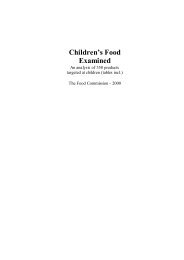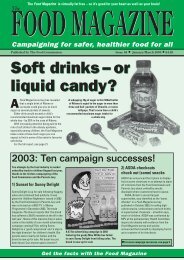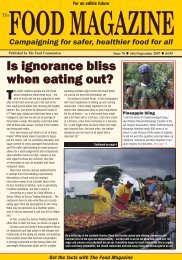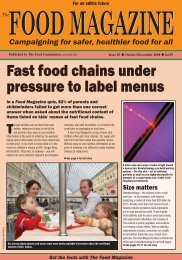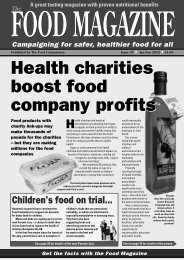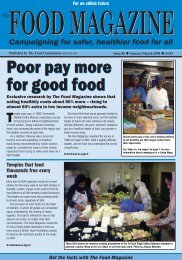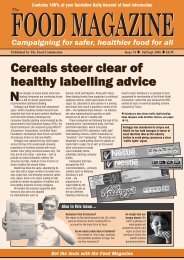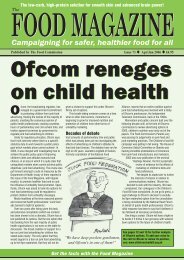Children's Nutrition Action Plan - The Food Commission
Children's Nutrition Action Plan - The Food Commission
Children's Nutrition Action Plan - The Food Commission
You also want an ePaper? Increase the reach of your titles
YUMPU automatically turns print PDFs into web optimized ePapers that Google loves.
• Improve the Welfare <strong>Food</strong>s Scheme (which currently gives pregnant women receiving<br />
means-tested benefits access to some free vitamins (A,C,D) and tokens for a pint of milk a<br />
day).<br />
♦ <strong>The</strong> milk tokens could be converted into more flexible food tokens. <strong>The</strong> Women,<br />
Infants and Children (WIC) programme in the U.S. shows that comprehensive<br />
nutritional support (via tokens for a range of nutritious foods) reduces the incidence of<br />
low birthweight and thus saves health service expenditure – $3 health costs saved for<br />
every dollar spent on WIC.<br />
♦ <strong>The</strong> limited vitamins available should be expanded to a wider range of vitamins and<br />
minerals associated with positive pregnancy outcomes.<br />
Issues for early pregnancy and pre-pregnancy nutrition<br />
This is a problematic period for intervention because an estimated 40% of pregnancies are<br />
unplanned, and a woman does not know she is pregnant in the earliest weeks. Intervention<br />
that starts only from confirmation of pregnancy will therefore miss a critical period for the<br />
developing child. <strong>The</strong> Acheson Report of the Independent Inquiry into Inequalities in Health<br />
(1998) acknowledges the need to adopt an intergenerational approach to tackling the cycle of<br />
poverty and poor nutrition, and to invest in the health and nutrition of girls and young women<br />
since they will be the mothers of the future. <strong>The</strong> school years are a key opportunity to<br />
improve the health of young women.<br />
Recommendations for future work:<br />
• Benefit levels should be set at a level to reflect a theoretical pregnancy, using one of the<br />
minimum income standards models to ensure that all out-of-work families have access to<br />
an adequate diet.<br />
• Improve disadvantaged women’s access to good quality, affordable fresh food by<br />
supporting community food projects.<br />
• Improve quality of food by imposing a legal obligation to replace nutrients lost in the<br />
processing of food (e.g. white flour).<br />
• Make comprehensive health information available to all women planning pregnancy.<br />
• Make welfare foods available on request to out-of-work women planning pregnancy.<br />
• Improve nutritional standards of school meals. Stronger guidelines are needed<br />
specifying serving sizes and nutrient content, perhaps on the U.S. model where meals<br />
must be consistent with the Recommended Dietary Allowances (RDAs) for specific<br />
nutrients.<br />
• Ensure universal access to school meals. Address the problem of nutritionally<br />
inadequate packed lunches brought in from home. Research whether parents find schoolprepared<br />
food unsatisfactory or too expensive and what would encourage higher take up.<br />
• Improve school teaching of nutrition and cooking skills.<br />
• Take action to reduce eating disorders.<br />
<strong>The</strong> Maternity Alliance, 45 Beech Street, 5 th Floor, London EC2P 2LX.<br />
<strong>The</strong> Children’s <strong>Nutrition</strong> <strong>Action</strong> <strong>Plan</strong>, published by <strong>The</strong> <strong>Food</strong> <strong>Commission</strong><br />
15



